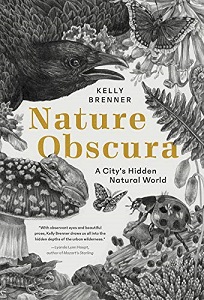
In this second year of seemingly never-ending plague,
Nature Obscura by Kelly Brenner speaks directly to our condition. What better time to learn the pleasures of urban nature? Even now with some formidable restrictions, we can walk in our neighborhoods and look closely. The book focuses on Seattle, but most of the species described can be found in any city.
Each chapter builds a biography of a different life form, some more obvious, like Anna’s hummingbird, and others harder to see, or to see as wondrous, like the algae and insects in Brenner’s backyard pond. She even makes slime mold appealing. For that example and several others, the budding urban naturalist will need a hand lens, or in some cases a microscope, to discover the intricacy and beauty of the subject.
In the chapter on dragonflies, Brenner begins by describing an adult emerge slowly from the larva. The description takes you right in: “Then the yellow eyes, still a muted brownish through the skin, begin to move like marbles sliding under a piece of tissue paper. . . Next the adult slides out of the skin as if being squeezed from a tube of toothpaste.” The chapter includes the author’s visits to wetlands in Eugene OR, discussion of the distressing loss of wetlands in the Puget Sound area, which dragonflies require, and more adventures with these insects at the constructed wetlands at Magnuson Park in Seattle.
Brenner urges readers to pay close attention to what they see around them, to “get their eyes in” to focus on nature. Dr. Seuss’s first picture book, “And To Think That I Saw It on Mulberry Street,” begins with a boy instructed to watch carefully for surprising things every day on his walk home from school. Seuss’s boy imagines fantastic rather than real discoveries. Brenner wants you to see the amazing in what is there in front of your eyes.
The book’s cover and a few well done but unlabeled black and white illustrations help the reader visualize Brenner’s subjects. Many more would be helpful. Instead, blossoming urban naturalists will need to pursue the excellent bibliography to find images and more information. Each of the sixteen life forms described in the book has its own list of reference works – a gold mine indeed.